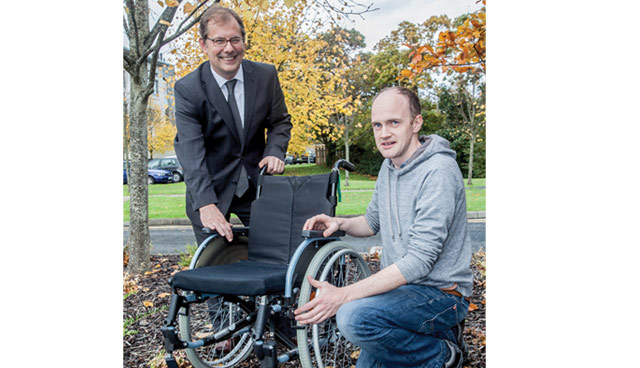Smart innovation


Nick Timmons, Co-founder and Director, WiSAR Lab at Letterkenny Institute of Technology details significant advances in the world of low-power, wireless sensor communications over the past 20 years and outlines some of the innovative projects being undertaken.
As we live our lives, we are unaware of the majority of wireless and connected devices, which are operational in such diverse areas as health, agriculture, food, transport, smart towns and cities, our homes, cars, sport, renewables, energy services, manufacturing, climate and weather and tourism. These wireless devices are affecting the sensing and monitoring, and ultimately the control of billions of decisions that directly and indirectly affect human beings every day.
This technology is bringing efficiency and innovation into all these industries and the growth of connected devices is exponential. In addition, we are only starting to scrape the surface of the eventual positive impact that this technology will have on our lives.
For example, currently in health we have wearable devices which can wirelessly monitor vital life signs, falls, blood pressure, blood glucose levels, nutrition, prescription drug intake, and location while on-the-move inside and outside of our homes. Great strides are being made to use this technology to give our elderly and the chronically ill greater independence by allowing them to remain in their homes for longer; with the added benefit of lessening the strain on our overburdened health services. This information can be used to continually update and alert carers and family members via tablets and smart phones, providing reassurance and independence to the loved ones.
These innovations have been driven in part by technological advances in areas such as semi-conductors, batteries, and communication protocols technologies, which has allowed us to build smaller wireless devices with increasing power efficiency. This, together with innovative antenna designs, which can be flat and conformal, mean that devices can be worn comfortably and unobtrusively on the body.
However, one of the key advances was the recognition 20 years ago by engineers that we needed some uniformity and standardisation around the low power wireless communication protocols. Up to that point, the low power wireless industry was centred on companies developing their own closed proprietary protocols for their own clients. In terms of commercial sales of these devices, this limited growth and these transceivers were typically used in wireless burglar alarm systems, garage door openers, toys, and other remote control devices. It was recognised that new wireless standards were required to kick-start the commercial growth of low power low data rate wireless systems.
So, in 2002 the IEEE oversaw the release of wireless standard aimed at low power and low data rate wireless communications – IEEE 802.15.4 (Zigbee). Unlike Bluetooth, which had been invented a few years earlier and was primarily aimed at cable free connection for emerging mobile phone handsets, this was targeted at low data rate, low power applications. The IEEE802.15.4 radio standard had several advantages over Bluetooth: the flexibility to reduce duty cycle to less than 0.1 per cent, thus permitting ultra-low power consumption and a battery life of years; the ability to self-organise into mesh networks with hundreds of devices allowing greater coverage area than Bluetooth, which was limited to a star point to point topology. Years later, a revised Bluetooth standard would be created which would address these shortcomings – Bluetooth Low Energy (BLE).
Also around this time (1998), researchers were beginning to be challenged by the concept of a pervasive or ubiquitous mesh networks of thousands of tiny smart fixed and mobile wireless devices sensing our physical environment and transmitting the data to a central hub for processing. This was the start of an intensive period of research in low power WSNs that went through various names and phases and which has culminated in what we now know as the Internet of Things (IoT).
In subsequent years, further wireless protocols were established including UWB IEEE802.15.4a, Bluetooth Low Energy (BLE) and wireless BAN standard IEEE802.15.6 – the WiSAR Lab contributed to the development of this standard aimed at body area networks. The most recent has been the development of a new wave of wireless systems aimed at IoT generically called Low Power Wide Area Network (LPWAN), and includes technologies such as SigFox, LoRA, and NB-IoT.
Although very different technologies, these LPWAN devices have longer communication ranges (up to 10s of kms) than Zigbee, Bluetooth and WiFi. In general, there is no penalty with power consumption but data rates are generally lower. However, the IoT class of devices has low data rate requirements due to the nature of environmental sensing of temperature, light, humidity, pressure etc. These new services will further boost the application and commercial opportunities. Over the last 20 years, these developments have resulted in a commercial growth explosion from one million connected devices in 1998 to a predicted 50 billion devices in 2020, with no slow down anticipated as yet.
“We are also currently working on the design of a smart ‘pill’ which can sense internal medical conditions and wirelessly transmit the data from inside the body as it passes through.”
After 10 years in industry as an RF engineer, I moved into academia in 1997. I had worked initially as an RF designer in the satellite industry but my latter years in industry were spent designing low power low data communications devices. As I moved into academia I could see the opportunities and the potential growth of this industry and I got involved initially with RF consultancy, and then research in 2004, which resulted in the establishment of the WiSAR Lab in 2008 at Letterkenny Institute of Technology.
We now have a team of 10, with over 150 man-years of experience in RF and wireless design and testing, embedded systems design, firmware and software, together with PCB design and prototyping services. We specialised in two areas: research and services to industry. The research work is in Body Area Networks (BANs), in particular ultra-low power MAC and routing protocols and ultra-low profile conformal antenna design. With services to industry we have worked with over two hundred companies to date ranging from projects in value from several thousand pounds up to hundreds of thousands. The WiSAR Lab is located near the border in Letterkenny Institute of Technology, Donegal, so our industry client base covers Northern Ireland as well as the Republic of Ireland. We are an Enterprise Ireland National Technology Gateway specialising in wireless solutions. We are also used by Invest NI clients who are funded though their voucher system. We also work on projects directly funded by industry.
To give a flavour of the work that we do, recent prominent projects have included the Finnlough Bubble Domes in County Fermanagh where we used wireless technology to monitor and control the inflation, temperature, and humidity of the bubble dome guest accommodation. In Newtownards, we are currently working with SeeSense, an innovative young company who have produced a bicycle smart light which also senses the environment and road conditions and will feed that information wirelessly into a smart city network using the emerging LPWAN systems.
We are leading a new EU funded project called SMARTrenew which will run for the next three years with focus on smart energy storage solutions for renewable sources, with partners including Donegal County Council and Derry City and Strabane District Council, and international partners from Norway, Finland, Iceland and the Faroes.
In fisheries, we have developed systems to allow crab trawlers to monitor their crab pots and sea conditions on the sea bed, and in a separate project we have developed sensor systems to monitor trawl net conditions, and log repair history. In health we have developed a smart wheelchair cushion cover which can sense pressure to provide a warning system for the prevention of pressure sores. We are also currently working on the design of a smart “pill” which can sense internal medical conditions and wirelessly transmit the data from inside the body as it passes through. We are currently commercialising a brand new antenna design for wearable wireless devices for sport, safety, and connected health.
This is only a small cross section of the type of applications for which WiSAR has provided solutions. In the application of this technology we are only limited by our imagination.





